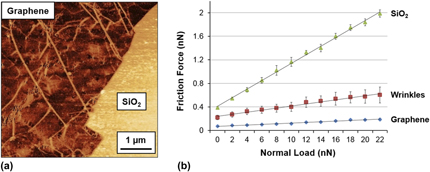Crossref Citations
This article has been cited by the following publications. This list is generated based on data provided by
Crossref.
Long, Fei
Yasaei, Poya
Yao, Wentao
Salehi-Khojin, Amin
and
Shahbazian-Yassar, Reza
2017.
Anisotropic Friction of Wrinkled Graphene Grown by Chemical Vapor Deposition.
ACS Applied Materials & Interfaces,
Vol. 9,
Issue. 24,
p.
20922.
Tripathi, Manoj
Awaja, Firas
Bizao, Rafael A.
Signetti, Stefano
Iacob, Erica
Paolicelli, Guido
Valeri, Sergio
Dalton, Alan
and
Pugno, Nicola Maria
2018.
Friction and Adhesion of Different Structural Defects of Graphene.
ACS Applied Materials & Interfaces,
Vol. 10,
Issue. 51,
p.
44614.
Afsharimani, Nasima
Uluutku, Berkin
Saygin, Verda
and
Baykara, Mehmet Z.
2018.
Self-Assembled Molecular Films of Alkanethiols on Graphene for Heavy Metal Sensing.
The Journal of Physical Chemistry C,
Vol. 122,
Issue. 1,
p.
474.
Pershin, Vladimir
Ovchinnikov, Kirill
Al-Hilo, Zaman
Memetov, Nariman
Tkachev, Alexey
and
Galunin, Evgeny
2018.
A graphene masterbatch for modification of frost-resistant plastic lubricants.
Vol. 2035,
Issue. ,
p.
020016.
Shen, Bin
Huang, Zhewei
Ji, Zhe
Lin, Qiang
Chen, Sulin
Cui, Danjie
and
Zhang, Zhinan
2019.
Bilayer graphene film synthesized by hot filament chemical vapor deposition as a nanoscale solid lubricant.
Surface and Coatings Technology,
Vol. 380,
Issue. ,
p.
125061.
Dagdeviren, Omur E.
Acikgoz, Ogulcan
Grütter, Peter
and
Baykara, Mehmet Z.
2020.
Direct imaging, three-dimensional interaction spectroscopy, and friction anisotropy of atomic-scale ripples on MoS2.
npj 2D Materials and Applications,
Vol. 4,
Issue. 1,
Acikgoz, Ogulcan
and
Baykara, Mehmet Z.
2020.
Speed dependence of friction on single-layer and bulk MoS2 measured by atomic force microscopy.
Applied Physics Letters,
Vol. 116,
Issue. 7,
Feng, Xin
Li, Lingling
and
Wei, Zhiyong
2020.
The effect of substrate on the tribological properties of graphene.
p.
377.
Huang, Zhewei
Lin, Qiang
Ji, Zhe
Chen, Sulin
and
Shen, Bin
2020.
The Interior Failure of Single‐Layer Graphene Activated by the Nanosized Asperity on the Substrate Surface.
Advanced Materials Interfaces,
Vol. 7,
Issue. 12,
Hussain, Sabir
Xu, Rui
Xu, Kunqi
Lei, Le
Meng, Lan
Zheng, Zhiyue
Xing, Shuya
Guo, Jianfeng
Dong, Haoyu
Liaqat, Adeel
Iqbal, Muhammad Ahsan
Li, Yan Jun
Sugawara, Yasuhiro
Pang, Fei
Ji, Wei
Xie, Liming
and
Cheng, Zhihai
2020.
Strain-induced hierarchical ripples in MoS2 layers investigated by atomic force microscopy.
Applied Physics Letters,
Vol. 117,
Issue. 15,
Shen, Bin
Chen, Sulin
Huang, Zhewei
Ji, Zhe
Lin, Qiang
and
Zhang, Zhinan
2020.
Elucidating the atomic mechanism of the lubricity of graphene on the diamond substrate.
Applied Surface Science,
Vol. 504,
Issue. ,
p.
144372.
Chen, Sulin
Shen, Bin
Huang, Zhewei
Ji, Zhe
Lin, Qiang
and
Zhang, Zhinan
2021.
Controlled friction on graphene via substrate deformation induced atomic pinning effect.
Computational Materials Science,
Vol. 190,
Issue. ,
p.
110315.
Zhang, Zhinan
Yin, Nian
Chen, Shi
and
Liu, Chengliang
2021.
Tribo-informatics: Concept, architecture, and case study.
Friction,
Vol. 9,
Issue. 3,
p.
642.
Keskin, Yasemin
Ünverdi, Özhan
Erbahar, Dogan
Kaya, İsmet İnönü
and
Çelebi, Cem
2021.
The role of charge distribution on the friction coefficients of epitaxial graphene grown on the Si-terminated and C-terminated faces of SiC.
Carbon,
Vol. 178,
Issue. ,
p.
125.
Huang, Zhewei
Chen, Sulin
Lin, Qiang
Ji, Zhe
Gong, Peng
Sun, Zhengzong
and
Shen, Bin
2021.
Microscopic Mechanisms Behind the High Friction and Failure Initiation of Graphene Wrinkles.
Langmuir,
Vol. 37,
Issue. 22,
p.
6776.
Huang, Zhewei
Chen, Sulin
Lin, Qiang
Ji, Zhe
Gong, Peng
Sun, Zhengzong
and
Shen, Bin
2022.
The mechanisms of friction enhancements on graphene surfaces with folds: The reinforcement of atomic pinning or attraction.
Tribology International,
Vol. 165,
Issue. ,
p.
107297.
Antonov, P. V.
Restuccia, P.
Righi, M. C.
and
Frenken, J. W. M.
2022.
Attractive curves: the role of deformations in adhesion and friction on graphene.
Nanoscale Advances,
Vol. 4,
Issue. 19,
p.
4175.
Gi Choi, Min
Park, Seonha
Lee, Habeom
and
Kim, Songkil
2022.
Correlating surface structures and nanoscale friction of CVD Multi-Layered graphene.
Applied Surface Science,
Vol. 584,
Issue. ,
p.
152572.
Adabasi, Gokay
Deshpande, Aditya
Tanaka, Koichi
Ancheta, Joshua
Maldonado, Emmanuel
Özdoğan, Mehmet
Kodambaka, Suneel
and
Baykara, Mehmet Z.
2023.
Nanoscale friction of high entropy alloy sulfide thin films in comparison with molybdenum disulfide.
Applied Physics Letters,
Vol. 123,
Issue. 26,
Mohammed, Anwaruddin Siddiqui
Dodla, Srihari
Katiyar, Jitendra Kumar
and
Samad, Mohammed Abdul
2023.
Prediction of friction coefficient of su-8 and its composite coatings using machine learning techniques.
Proceedings of the Institution of Mechanical Engineers, Part J: Journal of Engineering Tribology,
Vol. 237,
Issue. 4,
p.
943.
